Last Updated on January 24, 2024 by Greg Gillson
Dark-eyed Juncos (Junco hyemalis) are one of the most common birds at winter bird feeders in the United States. They may visit your backyard feeders. If they do, you will enjoy them more if you are able to identify them.
These small sparrows nest in openings in conifer and mixed forests in northern and mountainous areas of North America. In winter they migrate southward, being found nearly throughout the lower 48 states of the US.
This page is a supplement to the overview page on attracting Dark-eyed Juncos. The overview leads to other in-depth articles on food and diet, range and habitat, and nesting. This page discusses identification.
There is a wide variety of plumage variations across the range of Dark-eyed Juncos. So, what exactly do Dark-eyed Juncos look like? How do you tell them apart from other similar species? This article discusses size, shape, plumage coloration, voice, and flight style.
 |
|
Dark-eyed Junco
Phot by Greg Gillson
|
Junco identification, in general
Juncos are small little sparrows. They have a pudgy body, rather large head, small conical bill, and a fairly long tail with a straight end.
Juncos are frequently seen in the forest understory. They may perch regularly on the lowest branches of tall conifers within the forest. They also perch in understory and edge plants and bushes.
They seem to constantly make little twittering calls and trills.
They feed on the ground, hopping on bare spots searching for seeds. They often feed nervously, quickly flitting to nearby cover at any sign of danger or aggression from other juncos. But they quickly return to feeding on the open edges again.
All juncos share a tiny conical pink bill. But their tell-tale mark is the dark tail with white outer tail feathers that they spread and flash nervously and continuously.
There are 5 species of juncos in the world, from Panama to the Arctic. Within these are many additional sub-forms that vary widely in their plumage coloration. The Yellow-eyed Junco and the Dark-eyed Junco are the two species in the United States.
Juncos are part of the New World Sparrows. They have names such as sparrows, buntings, towhees, and juncos. But the names sparrows and buntings are also used for Old World birds that are not as closely related, but often look similar–seed eating birds with conical bills that are often colored in grays and browns, and frequently have unique head patterns.
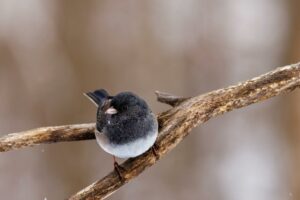
Dark-eyed Junco Identification
Dark-eyed Juncos range from 5 to 6.5 inches in length, from tip of the bill to end of the tail. They have a wingspan of about 7-9 inches. Their weight averages about 19 grams.
Plumage
The plumage of Dark-eyed Juncos is highly variable. At one time they were considered to be composed of at least 5 different species. But they were combined (“lumped”) in 1973 into one species, the Dark-eyed Junco. Wherever in their range that the different-looking forms come together they interbreed freely. Thus, it is not always possible to put an individual bird into one of the previously-named species or subspecies.
For convenience, I am dividing these juncos into 3 groups based broadly on how their plumage looks. Within these three groups I’ll describe some of the additional variations.
Slate-colored Junco group
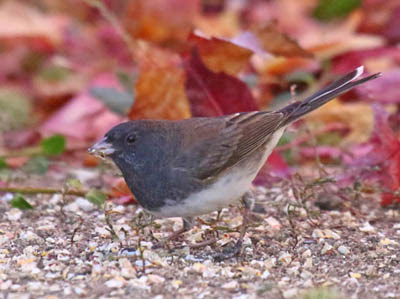 |
|
Slate-colored Junco
Photo by Greg Gillson
|
Slate-colored Junco (J. h. hyemalis and J. h. carolinensis)
This is a widespread northern and eastern form (breeding in Alaska and across Canada). It is common in winter in the Eastern and Central United Stated. Males of the Slate-colored Juncos are solid dark slate gray throughout with a white belly. The small bill is pink or whitish. The tail is blackish to dark gray with white outer tail feathers.
Females of the Slate-colored Juncos are a bit paler and brownish-gray, especially browner on the crown and back.
White-winged Junco (J. h. aikeni)
White-winged Juncos nest in the Black Hills of South Dakota and nearby and winter south to New Mexico. They are a bit bigger than other subspecies. Males are pale gray throughout with white belly and two thin wing bars. They have more white outer tail feathers than other groups.
Cassiar Junco (J. h. cistmontanus)
This form breeding in northern Alberta may be an intergrade between the Slate-colored Junco and the Oregon Junco. It is as the Slate-colored Junco in plumage coloration with one exception. The hood is slightly darker than the back but there is a noticeable line of demarcation between the two. This is true for both males and paler and browner females.
Oregon Junco group
 |
|
Oregon Junco
Photo by Greg Gillson
|
Oregon Junco (J. h. oreganus and 6 other subspecies)
There are several forms of Oregon Junco in the West, differing slightly in hue of back and sides. Males have jet black hoods that sharply contrast with a brown back. The small conical bill is pink. Wings are dark gray-brown. The tail is dark gray with white outer tail feathers. The belly is white. The sides are pinkish-cinnamon.
Females are similar, but the hood is pale gray. The brown of the back mixes with the gray hood up the back of the head.
Pink-sided Junco (J. h. mearnsi)
This form nests in the northern Rockies. The male Pink-sided Junco has a pale gray hood and brown back, looking very similar to females of other forms of Oregon Juncos. However, the lores (feathers between the bill and eyes) are black. The pink sides are so extensive that they may meet on the upper belly. Females are very similar to females of other forms, with a bit more pink on the sides.
Gray-headed Junco group
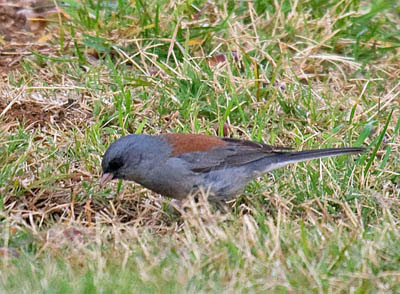 |
|
Gray-headed Junco
Photo by Greg Gillson
|
Gray-headed Junco (J. h. caniceps)
Gray-headed Juncos nest in the southern Rockies near the Grand Canyon. Adults are pale gray throughout, paling slightly and gradually to the white belly. The back is rufous-brown. The lores (feathers between bill and eyes) are black. The bill is entirely pale. Males and females are similar.
Red-backed Junco (J. h. dorsalis)
Red-backed Juncos are residents in the mountains of southern Arizona and New Mexico. Adults are similar to each other and similar to Gray-headed Juncos. The main difference is that the Red-backed Junco has a dark upper mandible and pale below. The throat is also paler.
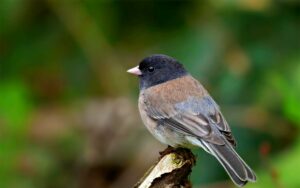
Flight style
I’ve never seen Dark-eyed Juncos fly very far during the day. When they do fly they seem to flap rapidly with occasional close winged glides (“flap-bound” flight style) and pump/spread their tails showing off the white outer tail feathers. Flight is often twisty or jerky.
When feeding, they are nervous and flit about, twisting and flying short distances. Even if they don’t fly they twitch their wings and flash their white tail feathers continuously.
When flushed they tend to fly upward. They land in the top of a short bush or bramble, or up to about 15 feet into bare tree branches.
There doesn’t seem to be any information on night-time migratory flight style, but I imagine it is probably more steady and direct, without the tail flashing. But that’s just my guess. They apparently migrate at rather low altitudes, because they are killed when they collide with buildings and wires at night more often than many other nocturnal migrant species.
Voice
What do Dark-eyed Juncos sound like? Well, they have many soft twittering notes that many people call a bell-like tinkling. They also have a long slightly musical trill on one pitch.
Calls include mostly soft short single “tik” or “spit” or similar notes, sometimes given in threes (“ti-ti-ti”). These calls are given continuously in social winter flocks. Paired birds in spring and summer also keep in constant communication.
Songs of Dark-eyed Juncos are usually a simple trill on one pitch. There is some variation so that some trills are more musical than others. Trills last about 3 seconds, sometimes with final single notes. Songs are more musical than Chipping Sparrows which have a dry trill of 4 seconds or so, but similar. Songs of Orange-crowned Warblers are also similar, but the musical trill of the warbler definitely slows and drops in pitch at the end. I find it is possible to be confused about which one of these birds is singing at a distance, especially in early spring when you haven’t heard them sing since the previous summer.
Bird watchers make spishing noises to attract the attention of these birds. Dark-eyed Juncos respond quickly to this noise by flying up into low tree branches above the intruder with harder “tik” calls, raised crown feathers, and full attention on the human interloper.
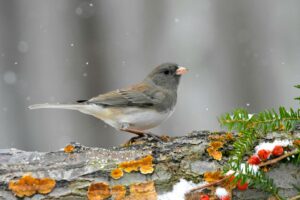
Similar species
Other junco species
Yellow-eyed Junco
In the United States there is only one other junco species–Yellow-eyed Junco. The Yellow-eyed Junco is most similar to the Red-backed Junco. Both are very pale gray with rufous backs and bicolored bills–dark above and pale below. Yellow-eyed Juncos have obvious yellow eyes and the rufous of the back extends onto the wing coverts.
There are a couple more junco species in Mexico and south to Panama. These tend to appear similar to the Pink-sided Junco pattern, with paler gray heads.
Other similar species
Vesper Sparrow
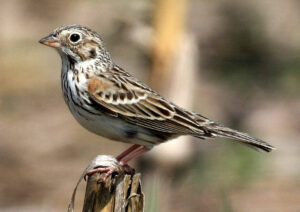
Juvenile Dark-eyed Juncos remain in a streaky brown sparrow-like plumage for 2-3 months after leaving the nest. Inexperienced bird watchers may mistake them for Vesper Sparrows. Both have white outer tail feathers. Juncos are birds of conifer forests; Vesper Sparrows are birds of open short grasslands or sage deserts.
Black-chinned Sparrow
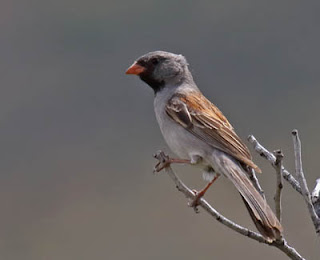 |
|
Black-chinned Sparrow
Photo by Greg Gillson
|
Black-chinned Sparrows are superficially very similar to juncos. They are small sparrows. They are medium gray on the head and body. They have brown and black streaked back and wings. They have a pink bill. All juncos have white bellies; Black-chinned Sparrows have all-gray bellies.
Black-chinned Sparrows breed in chaparral areas of the Southwest and winter into Mexico.
Spotted Towhee and Eastern Towhee
 |
|
Spotted Towhee
Photo by Greg Gillson
|
Black hood, reddish sides, white belly. The Spotted Towhee, even the Eastern Towhee, may superficially resemble the Oregon Junco. Juncos are small sparrows, towhees are very large sparrows. Spotted Towhees have white spots on the wing coverts and big white tail corners. The towhees have obvious red eyes. Towhees do not occur in flocks as do the juncos.
Black Phoebe
 |
|
Black Phoebe
Photo by Greg Gillson
|
The larger Black Phoebe is blackish-gray throughout with white belly. Phoebes sit upright in the open, usually low to the ground in a bush or on a fence line. From there they fly out to catch flying insects. They do not occur in flocks. They have a flat wide black bill. They bob their tail up and down.
Return to the Overview Page on Dark-eyed Juncos
Wrapping Up
The exact origin of the name “junco” for junco sparrows is a bit of a mystery. There are two main theories:
1. Spanish origin:
- The most widely accepted theory suggests that the name “junco” comes from the Spanish word “junco”, which means rush. It’s speculated that early Spanish explorers in the Americas might have compared the junco sparrow’s slender body and brown streaking to the thin, green stems of rush plants.
- This theory is supported by the fact that dark-eyed juncos, the most common junco species, were originally classified as Fringilla hyemalis, where “hyemalis” is a Latin word derived from the Greek word “cheimon”, meaning “winter”. So, the full scientific name “Fringilla hyemalis” essentially meant “winter finch”, referring to their habit of wintering in warmer regions.
- Later, when the “junco” name was adopted, it could have been seen as a more descriptive and vernacular alternative to the Latin name.
2. Confusion with European bunting:
- Another theory suggests that the name “junco” stemmed from confusion with a European bunting known as the “rosefinch” or “reed bunting”. This bunting was sometimes called “junco” in various European languages.
- Early naturalists in North America might have noticed some superficial similarities between the junco sparrow and the European reed bunting, and mistakenly applied the “junco” name to the American bird.
- However, this theory is less widely supported due to the lack of strong evidence for a direct connection between the two birds.
Ultimately, the exact origin of the name “junco” remains somewhat unclear. Both theories have some merit, and it’s likely that the true story involves a combination of factors and historical context.
Frequently Asked Questions
How many species of Junco are there?
Determining the exact number of Junco sparrow species is a bit complex, as different taxonomic authorities have varying opinions. Here’s a breakdown of the different perspectives:
Traditional classification:
- Traditionally, the genus Junco included three recognized species:
- Dark-eyed Junco (Junco hyemalis)
- Yellow-eyed Junco (Junco phaeonotus)
- Volcano Junco (Junco vulcani)
Modern views:
- Recent genetic studies and morphological analyses have led some taxonomists to propose splitting the genus further.
- For example, the American Ornithological Society (AOS) currently recognizes 12 species within the Junco genus. This classification primarily divides the Dark-eyed Junco into several distinct subspecies based on their unique geographical and genetic characteristics.
- Other organizations, such as the International Ornithological Committee (IOC), take a more conservative approach and still recognize only six species within the Junco genus. This stance acknowledges the genetic differences between some groups but hesitates to elevate them to full species status due to concerns about potential interbreeding and hybridization.
Therefore, depending on the taxonomic authority you follow, the answer to “how many Junco sparrow species are there?” can range from 3 to 12. The traditional classification of 3 species is still widely used, but the modern view recognizing 12 species is gaining traction due to increased scientific evidence.
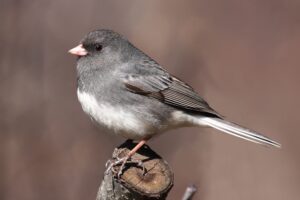
Do juncos and sparrows get along?
Juncos and sparrows, being closely related songbirds, generally get along well with each other. They often flock together, especially during migration or in winter, and share similar food sources and habitats. This peaceful coexistence often benefits both species:
- Increased vigilance: By foraging in mixed flocks, they can collectively keep an eye out for predators, improving their overall safety.
- Reduced competition: Sharing resources in large groups can help alleviate competition for food and nesting sites.
- Learning opportunities: Young birds can observe and learn foraging techniques and social behaviors from experienced individuals in other species.
However, minor competition can occur, particularly when resources are scarce. In such situations, larger or more aggressive species might temporarily dominate smaller ones when accessing food or nesting sites. Additionally, some territorial species might exhibit limited aggression towards others during the breeding season.
Overall, juncos and sparrows coexist peacefully for most of the year, benefiting from the advantages of flocking behavior and resource sharing. Their close relationship demonstrates the intricate interconnectedness of the avian world.
Where do juncos go at night?
Where juncos go at night depends on the season and their location:
Summer:
- During their breeding season, which typically lasts from April to July, juncos roost in the trees or shrubs near their nests. They prefer dense foliage that provides shelter from predators and the elements.
Winter:
- In winter, when their habitat becomes harsher, juncos shift to communal roosting. They gather in large groups and find shelter in various locations, depending on the available options:
- Evergreen trees: Dense evergreen foliage offers warmth and protection from wind and snow, making them a popular choice.
- Brush piles: Thick brush piles provide similar benefits to evergreen trees, attracting large numbers of juncos for communal roosting.
- Tall grasses: In the absence of other options, juncos may huddle together in tall grasses for some level of shelter.
- Man-made structures: In urban areas, juncos may utilize sheltered areas under bridges, eaves of buildings, or even abandoned cars for roosting.






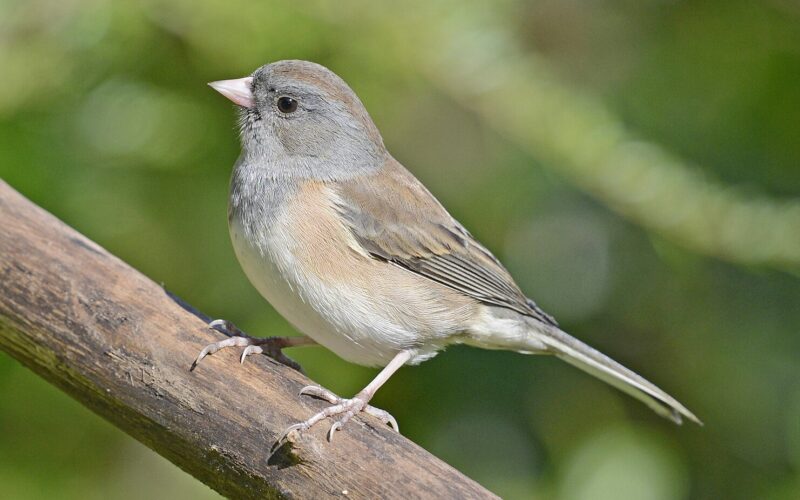
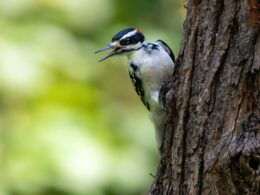
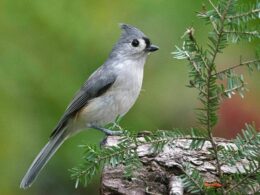
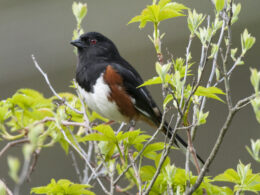
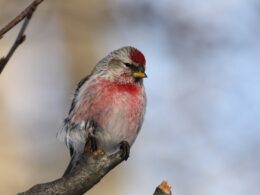
Thank you for the detailed information,as well as, the photos. I spotted a Junco in my yard and wondered what was this sweet little bird that I had not noticed before. Your information was just what I needed.
Wonderful! Thanks for letting me know.
yes! me too. I keep seeing them here in my east bay, by the bay home. Thanks so much!
You are very welcome!
I am seeing wonderful varieties of birds this winter. 1/22 Marysville, WA
RUBY Throated Hummingbird, Downy Woodpecker,Towhee, Black Capped Chickadee, Stiller blue, Rosy Finch, Dark eyed Junco (Oregon) Ruby Crown kinglet, Townsends Warbler, Red Breasted Nuthatch and about 12 tiny looks like baby junks? All on the suet at same time. I am not sure who they are!? Ideas?
We have suet..bird feeder & Hummingbird feeders lined up in front of dinning room window…there is a great bush…branches just 4 feet from window where they wait or maneuver their next try at feeding. So get a great view. I am a new birder! So great! Teaching my granddaughter how to identify while I learn. Thank you for info.
You are seeing a wonderful variety of birds!
The flock of little birds on the suet are likely Bushtits.
I might suggest that the hummingbird is Anna's and that rather than the glacier-loving rosy finches, they are probably the residential-loving House Finches.
Wonderful!